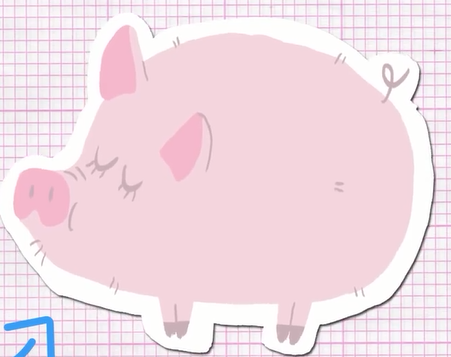Squeaks, it's a great day to be alive!
吱吱,活着真好!
And yes, I'm really living, and so are you!
我是活的,你也是活的!
But what does that mean? It sounds like a pretty simple question, right?
但这是什么意思呢?听起来是个相当简单的问题,不是吗?
There are living things all around us...as well as things that are not living.
我们周围都是生物,也遍布非生物。
When I was looking around the Fort's playground just a minute ago, I saw a rock, which is not a living thing.
我在一分钟前环顾沃斯堡的操场,看到了一块石头,它是非生物。
But the bird that were singing in the tree? That's definitely living.
但树上唱歌的鸟呢?它们当然是生物。
And the tree is, too!
树也是生物!
But sometimes the answer to the question of what's a living thing and what's not, can be a little tricky.
但有时生物和非生物的问题有点儿棘手。
I can hear a bird sing when I watch a video on a computer or phone,
我在电脑或手机看视频时也会听到鸟叫,
but, of course, computers and phones aren't living things...
但很明显,电脑和手机是非生物...
even though they might make sounds exactly like things that are alive.
即使它们发出类似生物发出的声音。
Scientists called biologists study all sorts of living things,
生物学家研究各种生物,
so they're the experts on what things are living, and what things are not.
所以他们是辨别生物和非生物的专家。
After studying all kinds of life, they discovered that everything that's alive, or was once alive, has a few things in common.
他们在研究了各种生命后发现所有的物体,不管是现在还是曾经活着的,有几个共同点。
You can think of them kind of as rules that all living things follow.
你可以考虑所有生物都遵循的规则
So let's take a look at some of these rules!
所以,我们来看看这些规则吧!
Rule number one: living things need energy.
规则一:生物需要能量。
You need energy to play and to do your school work.
你玩耍和做作业时需要能量。
A plant needs energy to make new leaves and to grow.
植物长新叶子和生长时需要能量。
Even some kinds of germs use energy when they make us sick!
甚至一些种类的细菌在使我们生病时都会用到能量!
Living things get energy in lots of different ways, but they all need it to stay alive.
生物有很多不同的方式获取能量,但它们都需要它来生存。
Okay, rule number two: Living things grow and change.
规则二:生物会生长和变化。
You're bigger than you were than when you were a baby, but you're not as big as you will be someday!
你比婴儿时期要高大,但你将来就不会这么大了。
And just like you, all living things grow and change,
和你一样,所有的生物都会生长和变化,
whether that means growing up, or getting more branches and making new leaves, like trees do.
就像树,不管是长大、冒出更多的枝条还是长新叶都会变化一样。
Alright, rule number three: Living things reproduce.
规则三:生物能繁殖。
Reproduce means to make more of something.
繁殖意味着生产更多的东西。
When living things reproduce, they make more of themselves!
生物繁殖时,能制造出更多像自己的生物。
For animals, that means having babies like kittens and puppies that will grow up to become adult cats and dogs.
例如,生下的小猫小狗,长大后成为成年猫狗。
For plants, that usually means making seeds that can grow into new plants.
对植物而言,繁殖通常意味着产生能长成新植物的种子。
Rule number four: Living things respond to the world around them.
规则四:生物会对周围的环境作出反应。
In other words, when something around a living thing changes, that living thing changes too.
换句话说,当生物周围的环境变化时,生物也会改变。
For example, when you get cold, you might shiver or put on a coat.
例如,你感觉冷时,可能会战栗或穿外套。
Both of these things will help warm you up.
这两件事都会让你暖和起来。
So that's how you respond to the cold.
所以这就是你对寒冷的反应。
And in the same way, in autumn, when the days start to get shorter and the weather gets cooler, some trees lose their leaves.
同理,秋天白天变短,气温下降,一些树会落叶。
They are responding to the change of seasons!
这是它们对季节变化的反应。
Great question, Squeaks!
吱吱,问得好!
What about the leaves that have fallen to the ground?
地面的落叶呢?
Are they living or not living?
是生物还是非生物?
Those leaves on the ground...even the brown, dead ones...were part of a living thing...the tree...
这些地上的叶子,即使是黄叶甚至是死叶,都曾是树这种生物的一部分...
so biologists say we still call them living things.
所以,生物学家仍称它们为生物。

Now, it might seem like there's some things missing from the rules.
现在,似乎有一些东西在规则中缺失了。
Like, what about...moving?
比如,移动?
When you think about it, a lot of living things move. But not all of them do.
你想到它时,很多生物都会移动。但不是全部。
Plants, for example, don't get up and walk around, but they're still alive!
比如植物不会起立和四处走动,但它们仍是生物!
And there are things that move that were never alive, like shadows, or the hands on a watch.
但有些东西会移动但不是活的,比如影子或手表指针。
Shadows don't use energy. And watches don't reproduce or grow.
影子不使用能量。手表不繁殖或生长。
So, if you're thinking like a biologist,
所以,如果你像生物学家一样思考时,
then something has to meet all of the rules in order for it to be considered a living thing.
被认为是生物的物体必须满足所有的规则。
If it doesn't, then it's not alive.
如果不满足,就不是生物。
Now, are you ready to test what you know about living things?
现在,你准备好测试你对生物的了解了吗?
It's game time! I'll name a thing, and you have to decide whether it's alive or not.
游戏时间到了!我说一个物体,你来决定它是不是生物。
First up, is an earthworm living or not living?
第一个,蚯蚓是生物吗?
If you said 'living', you're right!
如果你回答是,就答对了!
Earthworms need energy to wriggle through the soil. They also grow.
蚯蚓在土里蠕动时需要能量。它们也生长。
And they lay eggs that hatch into baby earthworms, which means they reproduce.
它们会产卵孵化幼虫,这意味着它们在繁殖。
And, if you've ever held up an earthworm, you know they respond to changes in the world around them.
如果你曾经拿起过蚯蚓,就会知道它们对周围世界的变化做出什么反应了。
If you pick one up, it tries to wiggle away! Next up.
如果你捡起一个,它会试着扭走!下一个!
Is a cloud living or not living?
云是生物还是非生物?
If you said 'not living', you're right!
如果你回答“非生物”的话就答对了!
A cloud may look like it grows because it might get bigger, say, before it rains.
云块在下雨前可能会变大,看起来似乎在长大。
But a cloud doesn't use energy, and it doesn't have baby clouds...so it doesn't reproduce.
但它不使用能量,也不会繁殖出云宝宝...所以它不会繁殖。
And since it doesn't follow all of the rules...it's not living!
因为它不符合所有的规则,所以它不是活的!
Okay. What about this stick? Is it living or not living?
那么树枝呢?是活的吗?
If you said 'living', you're right!
如果你说“是”,就说对了!
This stick is living because it was once part of a tree.
树枝是活的,因为它曾是树的一部分。
And, since the tree is a living thing, then the stick can also be called a living thing.
因为树是生物,那么树枝也被称为生物。
You can use these easy rules to study everything you see around you!
你可以利用这些简单的规则来研究你周围的事物!
Go for a walk outside, and take some time to stop and think about what you see, icicles, acorns, pebbles and grass
去外面走走,花些时间停下来思考你的所见:冰锥、橡子、鹅卵石或草,
and look at the clues we talked about: Are they alive or not?
看看我们讨论过的线索:它们是活的吗?
Thanks for joining us on SciShow Kids.
感谢您收看本期的儿童科学秀。
If you have a question for us, ask a grownup to help you to leave a comment down below,
如果你对我们有什么疑问,让大人帮忙在下方留言,
or to send an email to Kids@SciShow.com!
或发邮件至Kids@SciShow.com!
Thanks, and we'll see you next time, here at the Fort!
感谢您的收看,我们下期见,沃斯堡等你哦!












